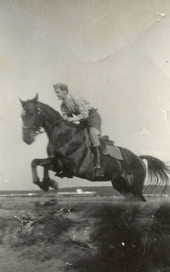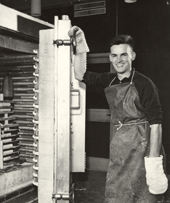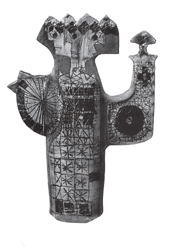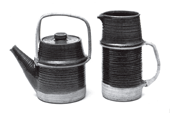|
1938.
On the brink of a second World War. In Sweden, the initial steps
were being taken towards social equalisation - what came to be known
as the People's Home. On January 17th Nils and Astrid Wallin's son,
Bertil was born.
Bertil
Wallin, and his six siblings grew up in a devoutly religious home,
in a residential suburban area north of Stockholm. Their father
had broken away from the Pentecostal Church in the 1950s, to form
a community of his own, The Prayer Society. Prayer meetings were
often held in the home. Bertil found the strictures of religion
conflicting.
-I rejected
the things I was taught as a child, Bertil relates. That particular
kind of free church religiosity - which threatened Hell and Damnation
if you didn't behave, was terrifying. And the fact that certain
things were considered sinful, things which to me were not in the
least bit sinful. A mass of prohibitions and restraints - that limited
my view of the world and my freedom. So I refused to accept it and
longed to get away. But I'm older now, and perhaps slightly more
humble, and I understand those questions to do with...well what?!
(To me) Religion is about the important issues, Life and Death and
the Life to come! And human love. The things I got from Sunday school
and from my father have, I feel, come back to me, in some measure.
And I'm quite grateful for it.
Bertil
was only fifteen when he left home, drawn by the allure of the big
city. Despite his hunger for life he was assailed by doubts: was
he right to deny his father's beliefs? What was he going to be?
-I had a great need to assert myself. I come from quite a simple
background, really. A working-class home, where there was very little
self-awareness. There was nobody to pit oneself against, no appreciation
of what I did. Apart from the fact that they loved watching me draw
horses. As far as a professional life was concerned, it wasn't until
I began at Konstfack (National College of Arts, Crafts and Design)
- that I got some feedback and was able to match my abilities against
my fellow students.
After
a series of occasional jobs, as a window-dresser at one of the main
department stores in Stockholm, and as an apprentice in his father's
decorating firm, Bertil decided to become an artist. He was accepted
for a 2-year foundation course at the National College of Arts,
Crafts and Design (Konstfack), 1955. He continued his training in
the Ceramics Department, under the guidance of Stig Lindberg - one
of Sweden's foremost designers of ceramic art. In Gunnar Lindqvist's
biography of Vallien, Bertil describes himself as "quite pompous".
He was determined to succeed and spared no effort, working both
by day and sometimes by night in order to achieve his goal. His
efforts were rewarded.
Bertil's
work at the college is influenced by Lindberg's expressive style.
In his final year /1961/ he was awarded a silver medal by the Swed.Handicraft
Society; he also won first prize in an inter-Nordic competition,
and graduated from the college with honours.The Stockholm News notes
that the Swedish king, who had shown great interest in the exhibition
of students' work at the College, purchased a ceramic piece made
by Bertil Wallin, and one by Ulrica Hydman. While Rebecka Tarschys,
from "Design Magazine" fell for Bertil's graduation piece:"His
ability to keep apart an exuberant and remarkable imagination from
a more universal form required for utility artefacts is impressive;
likewise a tempered ceramic bas-relief, on the theme of earth layers."
He received numerous offers of work.
The Director
of the Åfors factory, C-H Åfors, was eager to to take
him on (Bertil had already spent a training year at the factory).
His professional knowhow was sought by the Nyckelvikskolan in Stockholm
(vocational school of arts and crafts), for their summer course
in ceramics; and a certain Hal Fromhold
, in America, wished to engage his services
without delay.
He accepted
the offer from Nyckelvik, leaving in September for the US - where
the Hal Framholdt Ceramics awaited in downtown Los Angeles.
|

This
is the former building belonged to National Collage of Arts, Craft
and Design where Bertil Vallien was a studentfrom 1955 to 1961.
The photo was taken in 1958 by Yngve Hellström.

Bertil
Vallien at a horse during in his military service at K4 in Umeå,
1957.

The
ceramic atellier at the National College of Arts, Craft and Design,
1958. Photo:Tomas
Anagrius.

The
ceramic owen at the National College of Arts, Craft and Design 1959.
Photo:Sven-Gösta
Johansson.

A
sculpture from 1957. Bertil was deeply influenced by his teacher
Stig Lindberg.

Earthenware
teapot and jug - winning entries in an inter - nordic competition
in which schools of applied art took part.
|


